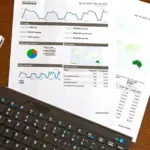SEO with Google Analytics: How it Works!
Google Analytics is a powerful tool for targeted web analysis and for improving the usability of your own web projects. But Google Analytics can also help the optimizer with targeted information for targeted search engine optimization, and in some functions, it outshines some professional SEO software.
In this blog post, we show you how you can use Google Analytics for your SEO with some workarounds. Here we go!
Google Analytics and SEO applications
The everyday life of a search engine optimizer is very data-driven. It consists largely of testing, testing, and testing again. As web analysis software, Google Analytics can be a helpful product for controlling measures and measuring success since traffic caused by SEO measures can be tracked directly. . Against this background, we have put together use cases and tips that can help you using Google Analytics.
Google Analytics SEO Tip 1: 404 HTTP Status Code Tracking
404 error pages refer to pages that cannot be found. At this point, link juice is wasted on the part of the search engine, and the triggering of 404 status codes is not ideal. Sure, the 404s can also be read out via Google Search Console, but here you only get the pages that were accessible to the search engine bot and not the pages that result from actual sessions. In order to be able to track the 404s in Google Analytics, the website must have its own 404 error page, which ideally also contains the term 404 in the page title. The 404 error pages and the linking sources can then be identified via Google Analytics.Google Analytics Quick Check!
Google Analytics SEO Tip 2: Google Search Console and AdWords
Data, data, data—the gold of SEO And to get more data in the Google Analytics view, it makes sense to link Google Analytics to Google Search Console and Google AdWords accounts. Now you have sufficient information about the keywords and the corresponding user behaviour. This data can then be used wonderfully to obtain new keywords for finding a topic.
Google Analytics SEO Tip 3: Documentation of the SEO Measures
It is often the case that you are constantly working on your SEO projects, and suddenly the organic traffic develops positively. But what was the issue now? – Was it the newly established link? – Or the newly imported meta data?
It quickly becomes apparent that the measures must be documented.
This is where Google Analytics can help: With the annotations function, measures can be documented in the Google Analytics timeline and shared within the team. In this way, all relevant people remain informed about the measures and their development. It is also possible to create a separate segment for the pages on which optimizations have been carried out and thus better understand the developments in the organic area.
Google Analytics SEO Tip 4: Page Speed (slowly loading websites)
Under Behaviour, Website Speed, and Loading Times, you can identify sub-pages of your website that have long loading times. These pages can then be passed on to web developers with the aim of minimising loading times in the long term.
Google Analytics SEO Tip 5: SEO Dashboards
A lot of data quickly makes analysis difficult and confusing. An SEO dashboard can help here. With Google Analytics, you have the option of creating your own dashboards and monitoring important key performance indicators. Especially from the point of view of traffic and conversion development, SEOs can receive helpful information from such a dashboard.
Google Analytics SEO Tip 6: Meta Data (CTR Optimization)
Metadata plays a crucial role in the click rate. With the integration of the Google Search Console, you have data regarding the click rates in Google Analytics, and you can also make adjustments here and define the test group in a separate segment. An increase in the CTR can be traced in the Google Analytics Dashboard.
Google Analytics SEO Tip 7: Alerts and Notifications
It can quickly become confusing. Setting up Google Analytics Alerts is a good way to bring order to chaos and be able to quickly identify trends. Here you can set, for example, that you will receive a notification from Google if the SEO traffic increases by 25% within a day. With these notifications, short-term developments can be monitored and quick interactions can be initiated.
Google Analytics SEO Tip 8: Identify Opportunities and Keywords
Once the interface to the Google Search Console has been set up, data such as the average position in analytics can be tracked. Here, you can now filter positions >10 and get search terms that stay on the second search result page on average. The optimization of these keywords means that you can get to the traffic-prone areas (the first search result page) faster and benefit from traffic via the search engine.
Google Analytics SEO Tip 9: Find backlink ideas
Under Referral,” you can quickly see pages that link to your own website. These sources can be used to generate further links to other areas of the website. For example, if a webpage links to a blog post, the webmaster can be contacted and asked to link to a transactional page as well.
Conclusion on SEO with Google Analytics
Google Analytics is a free and comprehensive web analysis programme that can deliver recognisable added value for the search engine. Of course, Google Analytics does not replace professional SEO software, but it can expand the existing data from third-party systems with real user data and thus offer SEOs even better control options. Start implementing our tips now and benefit from better search engine rankings for your company.
We are happy to support you, as a professional SEO agency, with your search engine optimization. Feel free to use our first and free SEO QuickCheck to get an insight into the current situation of your search engine optimization.





